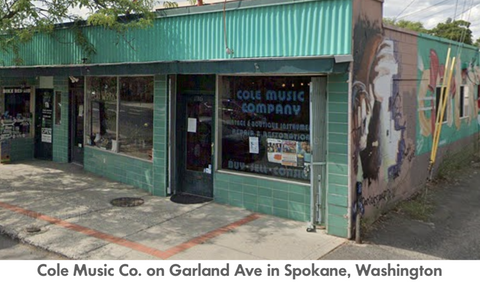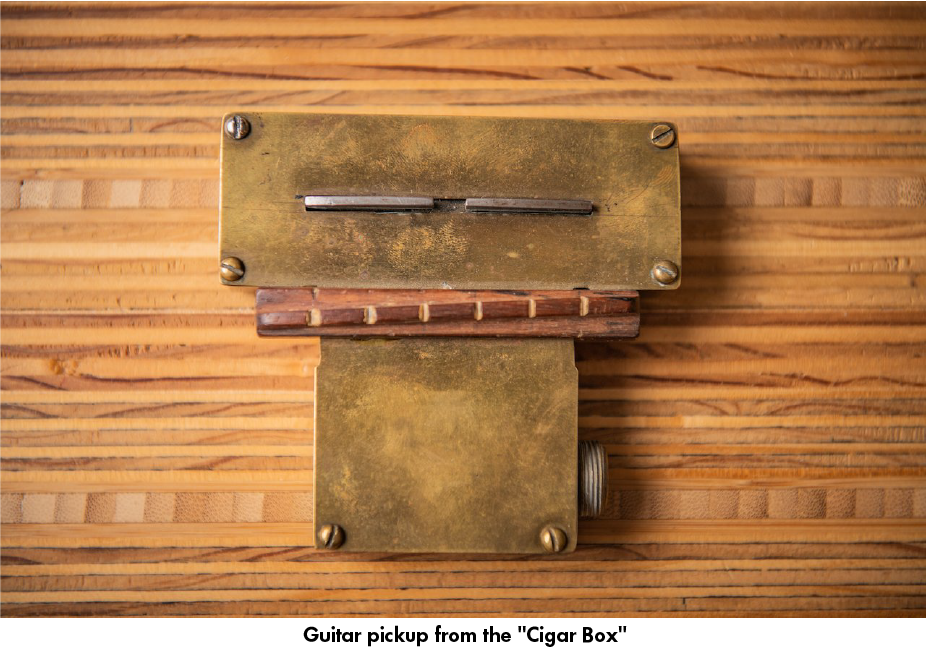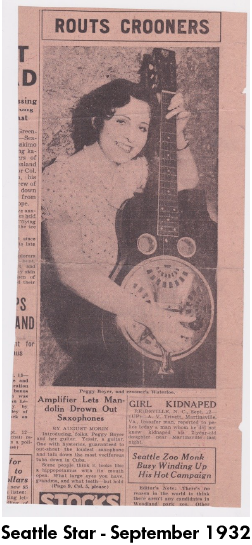Art Stimson: Spokane’s Missing Link in Electric Guitar History
Posted by Eben Cole on
I suppose most pundits are the same. Car guys are quick to point out the year and model of a passing Mustang. An enophile will enumerate the qualities of their favorite wine varietal. And my father can tell you what part of Europe a violin was made in from 10 feet away. Us guitar guys are certainly no different. Get enough of us together and it’s a race; who can spot the model and year of that Gibson by its appointments and headstock logo? We can be an insufferable bunch for the uninitiated, and more accurately, the uninterested. So be forewarned, this is going to be one of those insufferable nerdy-specific, deep dives, and it starts with a guy walking into a guitar shop.
A GUY WALKS INTO A GUITAR SHOP

Rich had resurrected his grandfather's old guitar and was considering taking guitar lessons. The guitar was in desperate need of work to make it playable though, so his teacher recommended he come see me before they got started. Personally, I have always enjoyed reading about the history and evolution of the guitar, and the deeper my acumen grew the more I gravitated to the obscura, the fringes of guitar history. Fortunately for me, I own a guitar shop, so that random cornucopia of six-stringed ephemera that is my burden to carry occasionally pays off. So when Richard ambled into my store on a balmy Saturday afternoon, I’m pretty sure he had no idea what he was in for.
That fateful afternoon Rich strolled in with, what I informed him was most likely an early 1920’s Gibson L3, (Initial assessment: ~8 seconds for those guitar nerds that want to race me). Intrigued, I asked him what the history was on it.
This is something I commonly do while evaluating a vintage guitar for repair. It puts the customer at ease and allows me to get intimate with someone’s instrument without that awkward silence. And to be honest, my attention typically gets split between listening to the customer’s story and assessing the piece. So when Richard started telling me about his grandfather I might have been half listening as I prepared a work estimate in my head.
One of the great things about family instruments is the value in the history, and the connection you can feel to that person when you play them. Generally the stories are the same, filled with family lore and reverence. Richard’s tale was no different. And, as I mentally added up repair charges in my head, I was catching bits of a story like many I had heard before.

Though Rich had never met him, he talked admirably about how this was his grandfather's guitar. How his granddad had always been a musician. How he played professionally in Seattle in the 1930’s. How he had invented a pickup for Dobro. How he was an aerial photographer… ***record scratch*** What?!? Back up. Invented a pickup for Dobro? That rings a bell I thought.
“Wait, are you talking about Arthur Stimson?” The look on Rich’s face was part astonishment and part concern. “How could he possibly know that?”, I could see him thinking.
Well, a few years back, I had read a fascinating article by guitar historian Peter Blecha. It told a little known story about the evolution of the electric guitar pickup and its origins in the Pacific Northwest; how two Seattle inventors, Paul Tutmarc and Arthur Stimson, invented a guitar pickup, and how Stimson sold the deign to Dobro, without acknowledging Tutmarc.
This is a know-it-all guitar pundit’s dream come true — to be able to tell a random stranger a bit of his family history steeped in guitar lore regarding a grandfather he’s never met? Read weird books kids, sometimes seemingly useless information pays off.
When Richard came back in, to pick up his guitar after the repair work was completed, we had a nice chat. I mentioned how cool it was to hear about his grandfather, and to know that the invention that literally changed the evolution of music history started here in our little city, Spokane. It was a cool story (practically unknown to the world), and I appreciated getting to revisit that bit of history. He wandered out, and I thought that was the end of it...until the cigar box.
THE CIGAR BOX

WHAT COMES NEXT
What comes next was a very interesting journey for Scott, myself, and the Stimson family. Over the next year, we endeavored to unearth as much as we could about Art Stimson’s contributions to the history of the electric guitar world and we did our best to understand this strange pickup found buried deep in a forgotten family steamer trunk. That being said, now would be the appropriate time to go over what we’ve decided is the best route forward for guitar history.
First, we want to help the Stimson family share their grandfather’s unique story. Art Stimson, it turns out, was a truly fascinating character. We’re going to give you the broad strokes here, and then we’re going to provide all the source documentation we found, and trust that others will take up the mantle. Guitar historians like David Wallis, Lynn Wheelright, and Peter Blecha are much more qualified to help this story come to fruition than we are, but we’d like to help get the ball rolling.
Second, we want to take a deep dive on this remarkable pickup from the cigar box. As I own a vintage music store and have been dealing in unique gear for some 15+ years, I feel this is much more in our wheelhouse. We assembled other experts as well, and have spent a goodly amount of time documenting and examining this pickup from every angle. Buckle up, nerds.
Full Disclosure: We also happen to have our own line of boutique pickups, coincidentally called “Missing Links” (named way before the cigar box wandered into our little store), and if this blog about a “missing link” in guitar history is shared far and wide — as we hope it will be, cause this is really cool stuff — we certainly wouldn’t mind selling the tone-conscious public some of our Missing Links as well. :)
ART STIMSON: A REMARKABLE MUSICIAN AND INVENTOR

Before we undertook this journey, guitar history didn’t have much to work with in regards to Art Stimson, and there is a lot of ambiguity regarding most accounts. What we knew was that Art Stimson was the name on the first Dobro patents for guitar pickups and he’s mentioned in The TRUE FACTS on the Invention of the Electric Guitar AND Electric Bass by Bud Tutmarc and an article by Peter Blecha called Tutmarc, Paul (1896-1972), and his Audiovox Electric Guitars, both of which have Paul Tutmarc’s son as the primary source. But other historians have pointed out that Tutmarc’s claims are most likely spurious as did Matthew William Hill, PhD in his thesis titled, George Beauchamp and the Rise of the Electric Guitar up to 1939.
After diving through Art’s family records though, there are a few things about Art Stimson that become quite apparent: For one, he was an archivist. He routinely took notes and recorded many of his business interactions, even if they were simple conversations. It is worthy to note, that nowhere in Art’s records is there a mention of Paul Tutmarc. Had the two collaborated as suggested, it is highly likely Art would have made a record of it somewhere, not to say this doesn’t exist, but we haven’t found one to date.

Second, Art was constantly inventing and improving ideas. His notebooks (pictured above) are full of sketches and unique musings, many of which he brought to life. He was experimenting with electronics and sound reproduction as early as age 15. And this early foundation gave him the principles needed to start his first foray into electrifying the guitar in 1924.
From Art’s archives, and his timeline, it seems he was always on the verge of “making it big”. Never quite at the right place at the right time, but always close. The following is a selected portion of Art’s timeline, focusing on his activities in the music and motion picture industry (for a more in depth look at check out Volume 62 of Issue 2 of The Pacific Northwesterner: Arthur J. Stimson: An Amazing & Versatile Spokane Man.) 1916 — Art started in the electronics business at age 15, before the word “electronics” was commonly used. He was building amateur HAM radio equipment for Doerr-Mitchell Co. in Spokane.
1916 — Art started in the electronics business at age 15, before the word “electronics” was commonly used. He was building amateur HAM radio equipment for Doerr-Mitchell Co. in Spokane.
1919 — Art files his first patent for an improvement on rotary internal combustion engines.
1922 — Art built the first radio station in Spokane, known as KFZ.
1924 — Art says he designed an electrically amplified guitar, consisting of a magnetic pick-up on the neck of the instrument. He also worked as a police reporter on a newspaper, a stenographer, and sold automobiles.
1925 — Louis Wasmer brought KHQ equipment to Spokane from Seattle. On October 2, 1925 KHQ went on the air. Art went to work for Wasmer on the maintenance and operation of the radio transmitter. After working for Wasmer, Art then began free-lance engineering on radio and electronic device control design. Until, he dropped engineering and started flying and making motion picture films. (Art writes in 1952 and photo of KHQ in Stimson Family Archive) (Partlow and Jorgenson in “‘The Early Days of Spokane Broadcasting” Centennial 1881-1981)
1926 — Art served in the National Guard. His photography business included his own motion picture laboratory in Spokane, making industrial film ‘trailers’, and some animated, scientific, and educational matter as well as aerial photography. According to Art, he designed and built a rectifying projector. This projector maintained a perfectly horizontal position while making mosaic photos.
1928 to 1930 — Art and his wife, Ovita, moved to Seattle, Washington, where he worked on commission for Olympic Studios in the design, construction, and operation of sound-on-film motion picture equipment. He wrote that he designed and built a sound-on-film recording system and played guitar for a radio station for extra income.

1930 to 1932 — Guitar Pickups
Art writes “being pressed into the necessity of making a living, I secured a connection with a radio station and played a guitar, having learned to do so in the previous experiments with the amplified guitar. This was fairly successful, and I received offers for stage appearances.
In newspaper stories during that time he is pictured playing the Theremin instrument at various venues in the Seattle area. Art writes he worked for the Electrophone Corporation in Seattle for a time, designing and producing magnetic and wire recording equipment at $200 a month. Art writes, “This company folded during the depression.” “My experimental work on the wire recording device led to the eventual design of an amplified guitar (which incidentally, was the first made)”.
He further says, he “remembered his earlier efforts at making the amplified guitar, and constructed another for the sole purpose of use, realizing that the inherent design was too elementary for production or manufacture. The instrument created a great deal of interest among the musicians and theatrical people of the area, and, … I set to work to design a practical model. This resulted in the production of an instrument with a magnetic array set under the strings, and, by means of variable permeability resulting from the motion of the steel strings, a completely practical instrument was built. This was taken to Los Angeles, and elaborate patent applications were prepared.” “...and this design I took to Los Angeles to the Dobro Company where I was gently aced out of the picture.”
He goes on, “After the failure to realize any returns from the transfer of rights [to Dobro] on the electrical guitar, he next secured a connection to design and construct a dual-table transcription recorder for the R.U. McIntosh Company for the production of radio serial plays. This device was completed and put into commercial use, but, again, financial failure of the company closed the operation.” (The above written by Art in 1952 in narrative to Dave Ward)
It’s during this time we get another narrative on this time period from “Tutmarc, Paul (1896-1972), and his Audiovox Electric Guitars”, by Peter Blecha

1932 — In September of 1932 newspapers begin reporting on Arts’ “amplification” device. Art is reported to have spent “two years of experimentation and hard work” developing the pickup. Placing the inception of the idea in 1930, as confirmed by his notes.
A full page article from the entertainment section of The Seattle Star dated September 24, 1932. ‘Two Seattle Musicians Succeed as Inventors. Arthur Stimson, radio guitarist, has new amplifying device for guitars which enables the player, by a simple turn of a knob to control volume of tone from a whisper to tone loud enough to be heard two blocks. A guitar tuned to this apparatus can, by further turn of the knob, be used as an ordinary Spanish guitar. Full clarity of guitar tones are retained, regardless of how many times the tone has been amplified….’ The other Inventor was Henry Francis Parks, a radio-theater organist.
It is important to note that in the article Art “selected” the Dobro for his experimentation, so he had already designed his pickup specifically for this instrument before taking it to LA. It is also of interest that the volume knob on the Dobro in the picture is mounted into the cover plate. On Production models the volume knob is mounted into the wood body.
He also worked on the design of an electrical organ. In late 1932-33 he is working for the Dobro Co. in Los Angeles performing design and perfection of amplified string instruments. Two patents are issued with his name as the inventor during his time at Dobro. In Los Angeles he, also, worked for a company designing and constructing a dual-table transcription recorder. (Art writes in 1952, a R. U. McIntosh business card, and a Ed Dopyera letter of recommendation dated January 6, 1934, in the Stimson Family Archive.)
1933 — In April, Art files for a patent on an “Electrophonic Stringed Musical Instrument”. (Patent #1,962,919) and Dobro releases it’s “All-Electric” model with a Stimson designed pickup.
1934 — Art files patent (#2,078,350) and receives a letter of recommendation from Ed Dopyera, President of Dobro Corporation. Art returned to Spokane where he opened a design and installation company, Stimson Sound Laboratories. He designed and manufactured sound equipment, police radio apparatus, and electronic devices. His last patent was for an automatic record changing system. On June 2, 1934 Rickenbacker/Electro String Instrument Corporation files patent #2,089,171 for it’s “Frying Pan” steel guitar with “Horseshoe Pickup”. Original prototypes used a blade style style pole piece similar to the Stimson Pickup design.
You can see we’ve linked to many of the source documents here and we can find no definitive connection between Stimson and Tutmarc yet there are clear similarities between their designs. We’re curious what these new materials may help guitar historians unearth and how that narrative will play out over time. We came away from this journey understanding Art Stimson to be a remarkable inventor, talented musician, and perhaps always just a step out of sync with landing his fortune. We appreciate all the fun we had with the Stimson family uncovering what we could about Art and hope he secures his rightful place in guitar history.
Special thanks to Richard Stimson (Art's grandson), Diane and Linda (Art's granddaughters), Leslie (Art's great granddaughter) and Lynn (Art's daughter-in-law). They were remarkably helpful and awesome to work with, we felt very lucky to get to explore this unique history with your family.
NEXT UP: THE CIGAR BOX PICKUP
And that, fellow guitar nerds, brings us to the unique pickup, found in a long forgotten family steamer trunk of the very first patent holder for a magnetic electric guitar pickup, brought into our little guitar shop in Spokane, Washington. We take a deep dive on this one-of-a-kind piece of music history. Stay tuned for that post coming shortly. :)
Other sources not directly linked to in post:
1950 Resume Letter to Kearns from Art Stimson
1952 Resume Letter to Dave Ward from Art Stimson
Seattle 1932 Article
Written by Eben Cole and Scott Mueller
- Tags: Guitar, Humbuckers, Pickups, Vintage
← Older Post Newer Post →
Art was my great grandfather. Having never known him, I’m amazed at how aptitudes seem to follow bloodlines. Art had many more interests and most of them are related to the science around waveforms. Like him, my history as a musician and working in wireless transmission and understanding it, echoes Art and his work. History has proven that the actual inventors and innovators rarely, if ever, are recognized or are the recipients financially of their genius and exploited by machiavellian marketers. But I digress. I am inspired by him and proud to be his great grandson.
The connector is an Amphenol 75, it was designed in December of 1935 and first appeared in the 1936 spring catalog. Hope this helps.
What a great story. Really enjoyed reading it. That was a lot of information and good writing. Looking forward to more!
Thank you, Eben and Scott.
I can hardly wait for Part 2.
What a find and what great fun, Eben! Thoroughly enjoyed the piece, and it’s clear that you had a great time putting it together.
You don’t have to be much of an ‘electric’ nerd to enjoy great guitar history. I’m still enjoying that amazing Pementel flamenco/classical-body/cutaway I bought from you last summer. See you soon.
Cheers, Don